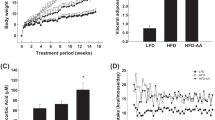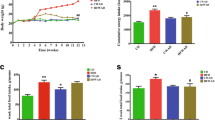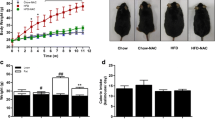Abstract
Background
Naringenin, a flavonoid present in grapefruit, has recently been shown to exert hypolipidemic and hypocholesterolemic effects, which has a particular importance for protecting against chronic diseases. However, the lipid-lowering potential of naringenin at the concentrations in the dietary range and its underlying mechanisms have yet to be fully elucidated.
Aim
The aim of the present study was (1) to investigate the effects of dietary naringenin on plasma and hepatic triglyceride and cholesterol levels and on adipose deposition in rat and (2) to determine the contribution of hepatic peroxisome proliferators–activated receptor α (PPARα) expression to fatty acid oxidation.
Methods
Male Long-Evans hooded rats were fed a diet supplemented with naringenin (0.003, 0.006, and 0.012%) for 6 weeks. We analyzed plasma and hepatic lipid contents and determined the protein expression of PPARα, carnitine-palmitoyl transferase 1L (CPT-1), and uncoupling protein 2 (UCP2), all of which are critical genes for fatty acid oxidation.
Results
Naringenin supplementation caused a significant reduction in the amount of total triglyceride and cholesterol in plasma and liver. In addition, naringenin supplementation lowered adiposity and triglyceride contents in parametrial adipose tissue. Naringenin-fed animals showed a significant increase in PPARα protein expression in the liver. Furthermore, expression of CPT-1 and UCP2, both of which are known to be regulated by PPARα, was markedly enhanced by naringenin treatment.
Conclusions
Our results indicate that the activation of PPARα transcription factor and upregulation of its fatty acid oxidation target genes by dietary naringenin may contribute to the hypolipidemic and anti-adiposity effects in vivo.


Similar content being viewed by others
References
Joshipura KJ, Ascherio A, Manson JE et al (1999) Fruit and vegetable intake in relation to risk of ischemic stroke. JAMA 282:1233–1239
Gorinstein S, Caspi A, Libman I et al (2006) Red grapefruit positively influences serum triglyceride level in patients suffering from coronary atherosclerosis: studies in vitro and in humans. J Agric Food Chem 54:1887–1892
Kurowska EM, Spence JD, Jordan J et al (2000) HDL-cholesterol-raising effect of orange juice in subjects with hypercholesterolemia. Am J Clin Nutr 72:1095–1100
Erlund I (2004) Review of the flavonoids quercetin, hesperetin, and naringenin. Dietary sources, bioactivities, bioavailability, and epidemiology. Nutr Res 24:851–874
Bok SH, Shin YW, Bae KH et al (2000) Effects of naringin and lovastatin on plasma and hepatic lipids in high-fat and high-cholesterol fed rats. Nutr Res 20:1007–1015
Choi MS, Do KM, Park YS et al (2001) Effect of naringin supplementation on cholesterol metabolism and antioxidant status in rats fed high cholesterol with different levels of vitamin E. Ann Nutr Metab 45:193–201
Lee SH, Park YB, Bae KH et al (1999) Cholesterol-Lowering Activity of Naringenin via Inhibition of 3-Hydroxy-3-Methylglutaryl Coenzyme A Reductase and Acyl Coenzyme A: Cholesterol Acyltransferase in Rats. Ann Nutr Metab 43:173–180
Santos KFR, Oliveira TT, Nagem TJ et al (1999) Hypolipidaemic effects of naringenin, rutin, nicotinic acid and their associations. Pharmacol Res 40:493–496
Lee CH, Jeong TS, Choi YK et al (2001) Anti-atherogenic effect of citrus flavonoids, naringin and naringenin, associated with hepatic ACAT and aortic VCAM-1 and MCP-1 in high cholesterol-fed rabbits. Biochem Bioph Res Co 284:681–688
Huong DTT, Takahashi Y, Ide T (2006) Activity and mRNA levels of enzymes involved in hepatic fatty acid oxidation in mice fed citrus flavonoids. Nutrition 22:546–552
Borradaile NM, de Dreu LE, Barrett PH, Behrsin CD, Huff MW (2003) Hepatocyte ApoB-containing lipoprotein secretion is decreased by the grapefruit flavonoid, naringenin, via inhibition of MTP-mediated microsomal triglyceride accumulation. Biochemistry 42:1283–1291
Borradaile NM, de Dreu LE, Huff MW (2003) Inhibition of net HepG2 cell apolipoprotein B secretion by the citrus flavonoid naringenin involves activation of phosphatidylinositol 3-kinase, independent of insulin receptor substrate-1 phosphorylation. Diabetes 52:2554–2561
Wilcox LJ, Borradaile NM, de Dreu LE, Huff MW (2001) Secretion of hepatocyte apoB is inhibited by the flavonoids, naringenin and hesperetin, via reduced activity and expression of ACAT2 and MTP. J Lipid Res 42:725–734
Allister EM, Borradaile NM, Edwards JY, Huff MW (2005) Inhibition of microsomal triglyceride transfer protein expression and apolipoprotein B100 secretion by the citrus flavonoid naringenin and by insulin involves activation of the mitogen-activated protein kinase pathway in hepatocytes. Diabetes 54:1676–1683
Kumpulainen J, Lehtonen M, Mattila P (1999) Trolox equivalent antioxidant capacity of average flavonoids intake in Finland. In: Kumpulainen JT, Salonen JT (ed) Natural antioxidants and anticarcinogens in nutrition, health and disease, Cambridge, pp 141–150
Vasilopoulou E, Georga K, Joergensen MB, Naska A, Trichopoulou A (2005) The antioxidant properties of greek foods and the flavonoid content of the mediterranean menu. Curr Med Chem 5:33–45
Foxworthy PS, Eacho PI (1991) Effect of the peroxisome proliferator LY171883 on triglyceride accumulation in rats fed a fat-free diet. Biochem Pharmacol 42:1487–1491
Staels B, Dallongeville J, Auwerx J, Schoonjans K et al (1998) Mechanism of action of fibrates on lipid and lipoprotein metabolism. Circulation 98:2088–2093
Lee HJ, Choi SS, Park MK, An YJ et al (2002) Fenofibrate lowers abdominal and skeletal adiposity and improves insulin sensitivity in OLETF rats. Biochem Bioph Res Co 296:293–299
Kim S, Shin HJ, Kim SY, Kim JH et al (2004) Genistein enhances expression of genes involved in fatty acid catabolism through activation of PPARα. Mol Cell Endocrinol 220:51–58
Murase T, Nagasawa A, Suzuki J, Hase T, Tokimitsu I (2002) Beneficial effects of tea catechins on diet-induced obesity: stimulation of lipid catabolism in the liver. Int J Obes Relat Metab Disord 26:1459–1464
Liu Li, Song S, Kun Z, Zhi-Qiang N et al (2008) Naringenin and hesperetin, two flavonoids derived from Citrus aurantium up-regulate transcription of adiponectin. Phytother Res 22:1400–1403
Allain CC, Poon LS, Chan CSG, Richmond W, Fu PC (1974) Enzymatic determination of total serum cholesterol. Clin Chem 20:470–475
Folch J, Lees M, Sloane Stanley GH (1957) A simple method for the isolation and purification of total lipides from animal tissues. J Biol Chem 226:497–509
Hsueh CT, Wu YC, Schwartz GK (2001) UCN-01 suppresses E2F–1 mediated by ubiquitin-proteasome-dependent degradation. Clin Cancer Res 7:669–674
Song J, Lu Y, Pang S, Chiu R (2004) An internal control for immunoblot analysis using the blotted membrane. Anal Biochem 331:201–203
Brady PS, Marine KA, Brady LJ, Ramsay RR (1989) Co-ordinate induction of hepatic mitochondrial and peroxisomal carnitine acyltransferase synthesis by diet and drugs. Biochem J 260:93–100
Kelly LJ, Vicario PP, Thompson GM, Candelore MR et al (1998) Peroxisome proliferator-activated receptors γ and α mediate in vivo regulation of uncoupling protein (UCP-1, UCP-2, UCP-3) gene expression. Endocrinology 139:4920–4927
Mascaro C, Acosta E, Ortiz JA, Marrero PF et al (1998) Control of human muscle-type carnitine palmitoyltransferase I gene transcription by peroxisome proliferator-activated receptor. J Biol Chem 273:8560–8563
Knekt P, Kumpulainen J, Jarvinen R, Rissanen H et al (2002) Flavonoid intake and risk of chronic diseases. Am J Clin Nutr 76:560–568
Wilcox LJ, Borradaile NM, Huff MW (1999) Antiatherogenic properties of naringenin, a citrus flavonoid. Cardiovasc Drug Rev 17:160–178
Wood N (2004) Hepatolipidemic effects of naringenin in high cornstarch-versus high coconut oil-fed rats. J Med Food 7:315–319
Kim S, Kim H, Lee M, Jeon S et al (2006) Naringin time-dependently lowers hepatic cholesterol biosynthesis and plasma cholesterol in rats fed high-fat and high-cholesterol diet. J Med Food 9:582–586
Lee MK, Moon SS, Lee SE et al (2003) Naringenin 7-O-cetyl ether as inhibitor of HMG-CoA reductase and modulator of plasma and hepatic lipids in high cholesterol-fed rats. Bioorgan Med Chem 11:393–398
Mouly PP, Arzouyan CR, Gaydou EM, Estienne JM (1994) Differentiation of citrus juices by factorial discriminant analysis using liquid chromatography of flavanone glycosides. J Agr Food Chem 42:70–79
Kasim SE, LeBoeuf RC, Khilnani S, Tallapaka L et al (1992) Mechanisms of triglyceride-lowering effect of an HMG-CoA reductase inhibitor in a hypertriglyceridemic animal model, the Zucker obese rat. J Lipid Res 33:1–7
Roglans N, Sanguino E, Peris C, Alegret M et al (2002) Atorvastatin treatment induced peroxisome proliferator-activated receptor α expression and decreased plasma nonesterified fatty acids and liver triglyceride in fructose-fed rats. J Pharmalcol Exp Ther 302:232–239
Neve BP, Fruchart JC, Staels B (2000) Role of the peroxisome proliferator-activated receptors (PPAR) in atherosclerosis. Biochem Pharmacol 60:1245–1250
Chitturi S, Farrell GC (2001) Etiopathogenesis of Nonalcoholic Steatohepatitis. Semin Liver Dis 21:027–042
Guerre-Millo M, Gervois P, Raspe E, Madsen L et al (2000) Peroxisome proliferator-activated receptor alpha activators improve insulin sensitivity and reduce adiposity. J Biol Chem 275:16638–16642
Keller J, Collet P, Bianchi A, Huin C et al (2000) Implications of peroxisome proliferator-activated receptors (PPARs) in development cell life status and disease. Int J Dev Biol 44:429–442
Mulvihill EE, Allister EM, Sutherland BG, Telford DE et al (2009) Naringenin prevents dyslipidemia, apolipoprotein B overproduction, and hyperinsulinemia in LDL receptor-null mice with diet-induced insulin resistance. Diabetes 58:2198–2210
Kim S, Sohn I, Lee YS, Lee YS (2005) Hepatic gene expression profiles are altered by genistein supplementation in mice with diet-induced obesity. J Nutr 135:33–41
Naaz A, Yellayi S, Zakroczymski MA, Bunick D et al (2003) The soy isoflavone genistein decreases adipose deposition in mice. Endocrinology 144:3315–3320
Kannappan S, Anuradha CV (2009) Naringenin enhances insulin-stimulated tyrosine phosphorylation and improves the cellular actions of insulin in a dietary model of metabolic syndrome. Eur J Nutr. doi: 10.1007/s00394-009-0054-6
Kawada T, Takahashi N, Fushiki T (2001) Biochemical and physiological characteristics of fat cell. J Nutr Sci Vitaminol (Tokyo) 47:1–12
Morikawa K, Nonaka M, Mochizuki H, Handa K et al (2008) Naringenin and hesperetin induce growth arrest, apoptosis, and cytoplasmic fat deposit in human preadipocytes. J Agric Food Chem 56:11030–11037
Okuno A, Tamemoto H, Tobe K, Ueki K et al (1998) Troglitazone increases the number of small adipocytes without the change of white adipose tissue mass in obese Zucker rats. J Clin Invest 101:1354–1361
Acknowledgments
This research was in part supported by Grants (S00000005000000) from the University of Massachusetts, Amherst.
Author information
Authors and Affiliations
Corresponding author
Additional information
Kae Won Cho and Yong Ook Kim have contributed equally.
Rights and permissions
About this article
Cite this article
Cho, K.W., Kim, Y.O., Andrade, J.E. et al. Dietary naringenin increases hepatic peroxisome proliferators–activated receptor α protein expression and decreases plasma triglyceride and adiposity in rats. Eur J Nutr 50, 81–88 (2011). https://doi.org/10.1007/s00394-010-0117-8
Received:
Accepted:
Published:
Issue Date:
DOI: https://doi.org/10.1007/s00394-010-0117-8




